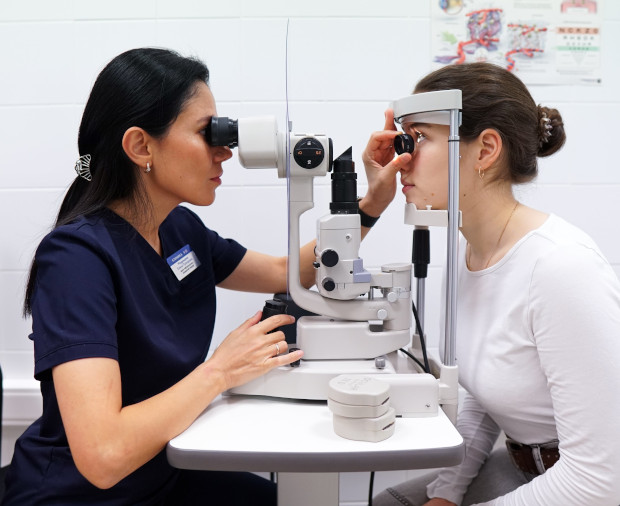Лечение апоплексии (разрыва) яичника

specialists

equipment

treatment
Causes of ovarian apoplexy
Main reasons
There are a number of key reasons that lead to the development of ovarian apoplexy:
- Hormonal changes. Ovulation itself is a period of increased risk, since it is at this time that the load on the vessels and connective tissue of the ovaries increases
- Vascular diseases. Pathologies that lead to a decrease in the elasticity of the vessel walls, such as varicose veins of the pelvis or vasculitis, increase the likelihood of a rupture of a vessel in the ovarian tissue
- Physical activity. Intense exercise, sports training and abdominal injuries can trigger a rupture
- Pathological processes in the body. Various inflammatory diseases of the female genital tract, infections and neoplasms also contribute to the development of apoplexy
- Use of drugs. Some medications that affect hormones or increase vascular fragility can increase the likelihood of developing apoplexy
- Hereditary predisposition. The genetic factor plays a role in the development of some vascular pathologies that increase the chances of apoplexy
- Age factors. Although the main risk group is young women, hormonal imbalances during menopause can also cause this condition
- Physiological stress. A sharp increase in intra-abdominal pressure caused by coughing, straining, or lifting heavy objects can provoke a pathological rupture
These causes often act together, creating favorable conditions for the development of apoplexy.
Predisposing factors
In addition to the immediate causes, there are predisposing factors that can increase the likelihood of developing ovarian apoplexy. These include:
- Presence of inflammatory diseases of the pelvic organs (for example, adnexitis)
- Impaired blood circulation in the pelvic organs caused by the incorrect position of the uterus or the presence of tumors
- Use of drugs that stimulate ovulation, such as clostilbegyt or gonadotropins
- Stressful situations and chronic fatigue, which negatively affect the general immunity of the body
- A history of gynecological operations that weaken the structure of ovarian tissue
- Varicose veins of the pelvis, leading to increased vascular fragility
- Abortions and other interventions that violate the integrity of the ovarian mucosa
- The impact of bad habits, such as smoking and drinking alcohol, which impair microcirculation blood
- Difficult childbirth, accompanied by damage to internal organs and disruption of the normal functioning of the endocrine system
Timely detection and elimination of these factors can significantly reduce the likelihood of ovarian apoplexy.

Ovarian Apoplexy and Pregnancy
Women who are pregnant are at risk for developing ovarian apoplexy due to the physiological changes that occur in the body during pregnancy. Many experts argue that pregnancy itself is rarely the direct cause of ovarian apoplexy. However, certain circumstances and associated factors may contribute to this condition.
During pregnancy, significant changes occur in a woman's body, including an increase in the size of the uterus, a change in the position of the abdominal organs, and an increase in the load on the blood vessels. This puts additional pressure on the pelvic organs, which increases the risk of injury and subsequent rupture of the ovary.
In addition, hormonal fluctuations typical for pregnant women affect the condition of the blood vessels and the structure of the ovaries. Such changes can weaken the walls of the vessels and increase their tendency to rupture.
Classification of ovarian apoplexy
Severity levels
The more blood a woman has lost, the more severe the pathology is considered. It is customary to distinguish three degrees of severity of apoplexy:
- Mild - it is diagnosed when the volume of blood loss is less than 150 milliliters. Usually, a woman feels mild pain in the lower abdomen, small brown discharge is possible. As a rule, the general condition of the patient remains satisfactory, blood pressure remains stable, pulse is normal. Such bleeding is often treated conservatively
- Moderate - it is established when there is a loss of 150 to 500 milliliters of blood. Symptoms become more pronounced: the pain intensifies, weakness, dizziness, nausea appear, sometimes vomiting occurs. Blood pressure decreases moderately, the heartbeat increases. The woman requires hospitalization and close medical supervision
- Severe degree - with this form of ovarian rupture, blood loss exceeds 500 milliliters, which poses a threat to the woman's life. This is accompanied by sudden pain, a significant decrease in blood pressure, weakness, pale skin, cold sweat, rapid pulse and even loss of consciousness. Without timely medical care, this situation can lead to shock and serious complications
With a severe degree of apoplexy, the patient needs urgent surgery to stop the bleeding and intensive care to restore the body's vital functions.
Types of apoplexy
In medical practice, it is customary to distinguish several main forms of the disorder:
- Pain type. It is characterized by severe discomfort. Painful sensations are localized mainly in the lower abdomen, often only on one side. Bleeding is insignificant or absent altogether, symptoms are limited exclusively to pain syndrome
- Hemorrhagic type. The main manifestation is associated with internal bleeding of significant intensity, capable of provoking a sharp decrease in the level of circulating blood in the body (hypovolemia). Clinical signs include a significant drop in blood pressure, rapid heartbeat, a feeling of general weakness. Sometimes the patient needs surgical assistance
- Mixed type. Combines the symptoms of both previous forms: there are severe pain sensations along with signs of significant internal bleeding
The last type of pathology is most common. Since the symptoms of the disease are rapidly increasing and the risk of complications is increasing with each passing minute, the mixed type of pathology requires immediate medical attention.
Signs and symptoms
Treatment methods
Conservative methods
In mild forms of the lesion, when the volume of blood loss is small and the woman's health is stable, preference is given to conservative measures. This approach involves strict rest, taking analgesics, anti-inflammatory drugs and drugs that stop bleeding. Also, to reduce inflammation, they practice applying cold to the abdomen.
Surgical methods
In case of significant circulatory disorders or signs of deterioration of the general condition, the only way out is surgical intervention. The most popular type of surgery is laparoscopy. This is a minimally invasive procedure performed in a clinic using several small punctures in the abdominal wall. A camera and special microsurgical instruments are inserted through them, allowing the normal structure of the affected organ to be restored.
In case of deep injuries to the ovarian tissue, methods of suturing it or removing part of the organ are used. In particularly serious clinical situations, when it is not possible to stop bleeding with small means, they resort to traditional open surgery - laparotomy, which involves wide access to the pelvic cavities.
The extreme option for surgical intervention is the complete removal of the affected ovary. Such an operation is called oophorectomy. This step is taken only when preserving the reproductive organ is impossible and the threat to the patient's health is too high.

Rehabilitation after treatment
If laparoscopy was performed, the patient will have a short rehabilitation period with a low risk of complications. A day or two after the procedure, the woman can return home.
A short course of antibacterial therapy is recommended to avoid infectious consequences. The stitches are removed about a week and a half after the operation. Laparoscopic holes are almost invisible.
A full rehabilitation cycle takes about three to four weeks. The doctor may recommend additional medication - drugs to relieve pain, eliminate inflammation or normalize hormonal levels.
To prevent unwanted consequences after the intervention, doctors advise limiting physical activity, refraining from visiting baths and saunas, and excluding intimacy for at least a month after the operation.
Prognosis and prevention
Timely detection of ovarian damage and competent medical intervention ensure a positive outcome that preserves the ability to bear children. However, the presence of pathology increases the need for a cautious attitude to the course of subsequent pregnancy. It is important to regularly visit a doctor and strictly follow his recommendations.
Preventing relapses requires regular monitoring of women's health, contacting a specialist when alarming symptoms appear, and systematically undergoing preventive examinations. It is also necessary to promptly treat any inflammatory processes in the female genital area.
It is important to consider risk factors that can increase the likelihood of relapse and try to minimize their impact: avoid excessive emotional experiences, high physical activity and other stressful situations.


This award is given to clinics with the highest ratings according to user ratings, a large number of requests from this site, and in the absence of critical violations.

This award is given to clinics with the highest ratings according to user ratings. It means that the place is known, loved, and definitely worth visiting.

The ProDoctors portal collected 500 thousand reviews, compiled a rating of doctors based on them and awarded the best. We are proud that our doctors are among those awarded.
Make an appointment at a convenient time on the nearest date
Price






































































General information
Ovarian apoplexy is a hemorrhage into the ovarian tissue. It occurs when a blood vessel in the ovary bursts. Most often, the rupture occurs in cysts of the organ. As a rule, the vessels rupture in the corpus luteum cyst or follicular formation. In most cases, apoplexy occurs in the middle of the menstrual cycle, when the mature egg leaves the follicle (the process of ovulation).
Blood accumulates inside the ovary or flows out, getting into the abdominal cavity. Because of this, there is a sharp pain in the lower abdomen, weakness, dizziness and sometimes nausea. The symptoms can be so severe that the woman loses consciousness or goes into shock.